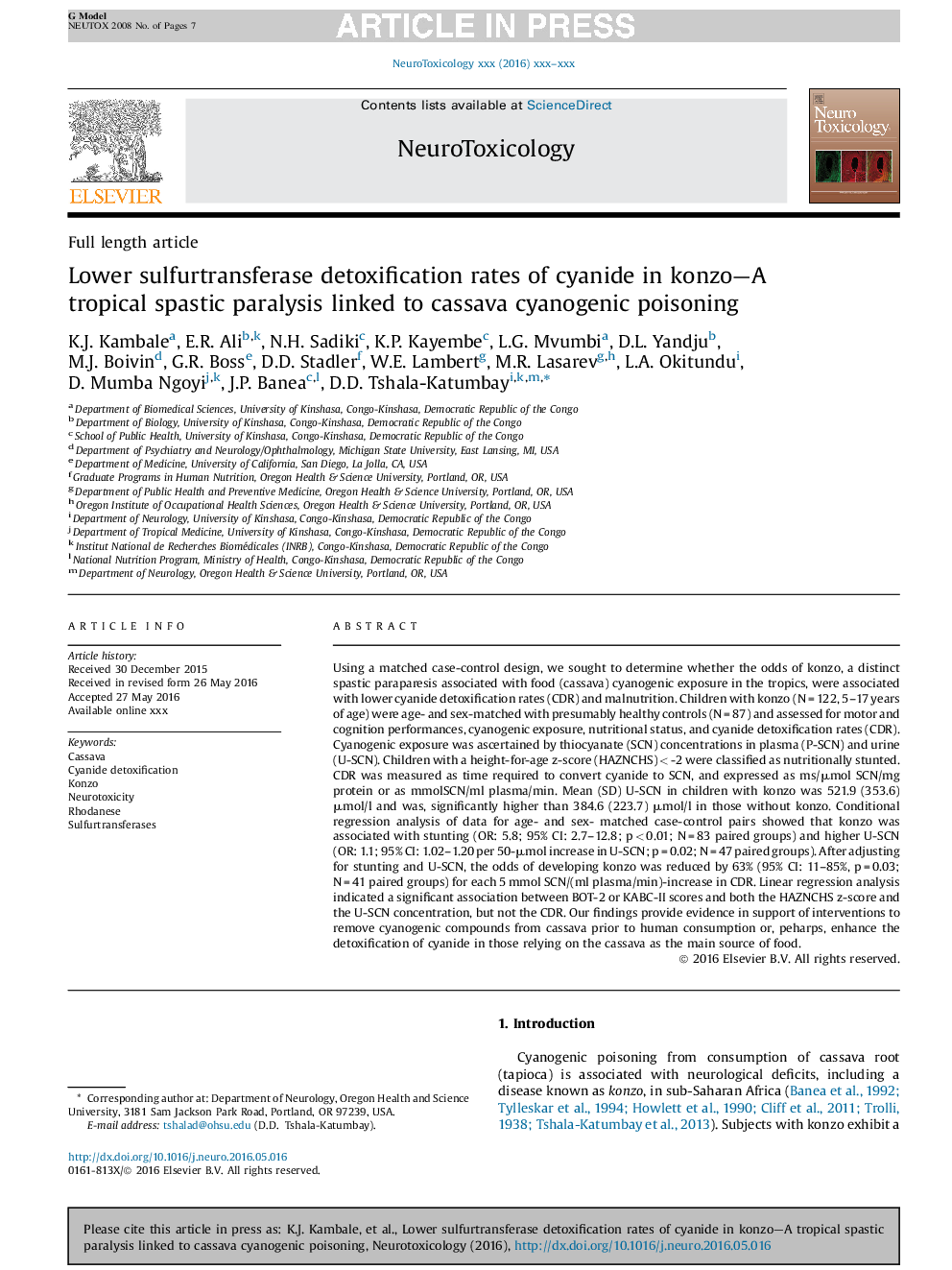| کد مقاله | کد نشریه | سال انتشار | مقاله انگلیسی | نسخه تمام متن |
|---|---|---|---|---|
| 5560963 | 1562035 | 2017 | 7 صفحه PDF | دانلود رایگان |
عنوان انگلیسی مقاله ISI
Lower sulfurtransferase detoxification rates of cyanide in konzo-A tropical spastic paralysis linked to cassava cyanogenic poisoning
دانلود مقاله + سفارش ترجمه
دانلود مقاله ISI انگلیسی
رایگان برای ایرانیان
کلمات کلیدی
موضوعات مرتبط
علوم زیستی و بیوفناوری
علوم محیط زیست
بهداشت، سم شناسی و جهش زایی
پیش نمایش صفحه اول مقاله

چکیده انگلیسی
Using a matched case-control design, we sought to determine whether the odds of konzo, a distinct spastic paraparesis associated with food (cassava) cyanogenic exposure in the tropics, were associated with lower cyanide detoxification rates (CDR) and malnutrition. Children with konzo (N = 122, 5-17 years of age) were age- and sex-matched with presumably healthy controls (N = 87) and assessed for motor and cognition performances, cyanogenic exposure, nutritional status, and cyanide detoxification rates (CDR). Cyanogenic exposure was ascertained by thiocyanate (SCN) concentrations in plasma (P-SCN) and urine (U-SCN). Children with a height-for-age z-score (HAZNCHS) < -2 were classified as nutritionally stunted. CDR was measured as time required to convert cyanide to SCN, and expressed as ms/μmol SCN/mg protein or as mmolSCN/ml plasma/min. Mean (SD) U-SCN in children with konzo was 521.9 (353.6) μmol/l and was, significantly higher than 384.6 (223.7) μmol/l in those without konzo. Conditional regression analysis of data for age- and sex- matched case-control pairs showed that konzo was associated with stunting (OR: 5.8; 95% CI: 2.7-12.8; p < 0.01; N = 83 paired groups) and higher U-SCN (OR: 1.1; 95% CI: 1.02-1.20 per 50-μmol increase in U-SCN; p = 0.02; N = 47 paired groups). After adjusting for stunting and U-SCN, the odds of developing konzo was reduced by 63% (95% CI: 11-85%, p = 0.03; N = 41 paired groups) for each 5 mmol SCN/(ml plasma/min)-increase in CDR. Linear regression analysis indicated a significant association between BOT-2 or KABC-II scores and both the HAZNCHS z-score and the U-SCN concentration, but not the CDR. Our findings provide evidence in support of interventions to remove cyanogenic compounds from cassava prior to human consumption or, peharps, enhance the detoxification of cyanide in those relying on the cassava as the main source of food.
ناشر
Database: Elsevier - ScienceDirect (ساینس دایرکت)
Journal: NeuroToxicology - Volume 59, March 2017, Pages 256-262
Journal: NeuroToxicology - Volume 59, March 2017, Pages 256-262
نویسندگان
K.J. Kambale, E.R. Ali, N.H. Sadiki, K.P. Kayembe, L.G. Mvumbi, D.L. Yandju, M.J. Boivin, G.R. Boss, D.D. Stadler, W.E. Lambert, M.R. Lasarev, L.A. Okitundu, D. Mumba Ngoyi, J.P. Banea, D.D. Tshala-Katumbay,